Fatigue Evaluation of CFST Arch Bridge Based on Vehicle–Bridge Coupling Vibration Analysis
Abstract
:1. Introduction
2. Description of the Bridge
3. Bridge–Vehicle Dynamic Interaction Model
3.1. Vehicle Model Parameters
3.2. Bridge Model Parameters
3.2.1. Geometric Model
3.2.2. Material Parameters
3.2.3. Loading Condition
3.2.4. Road Roughness Simulation
3.3. Vehicle–Bridge Coupled Vibration Analysis Model
3.4. Fatigue Assessment Method
4. Dynamic Parameter Analysis
4.1. Verification of Numerical Analysis
4.2. Dynamic Parameter Analysis
4.2.1. Vehicle Speed
4.2.2. Vehicle Weight
4.2.3. Road Surface Condition
4.2.4. Results of Key Position
5. Fatigue Analysis
5.1. Fatigue Life Estimation
5.2. Fatigue Reliability under Corrosion
6. Conclusions
- (1)
- While the effect of vehicle speed on the dynamic performance of the bridge is relatively small, it should be noted that the frequency caused by a change in vehicle speed gradually approaches a certain order of the bridge’s vertical bending frequency, leading to a resonance phenomenon. Compared to vehicle speed and road surface condition, the response time history results are more sensitive to vehicle weight. The increased proportion between vehicle weight response and displacement time history is basically the same. With an increase in the road surface condition, the oscillation degree increases, and this phenomenon is more evident in the acceleration time history.
- (2)
- Under vehicle loads, the fatigue cycle number of the bridge’s subside span suspenders is relatively smaller, compared to the central span suspenders; that of outer suspenders is significantly lower than that of inner suspenders from the cross-sectional direction of the bridge; and the fatigue life of short suspenders is significantly less than that of longer suspenders.
- (3)
- Environmental corrosion reduces the effective cross-sectional areas of suspenders, substantially raising their cyclic stresses when subjected to vehicle loads, especially for bridges with heavy vehicle loads and poor road conditions. Thus, specific consideration is required during the evaluation and analysis of suspender fatigue life.
- (4)
- Improving structural dynamic performance is necessary for a long-serving CFST arch bridge. The proposed fatigue evaluation method based on the vehicle–bridge coupled vibration analysis system reflects the structure’s dynamic performance well.
Author Contributions
Funding
Data Availability Statement
Conflicts of Interest
References
- Chen, B.; Wang, T. Overview of Concrete Filled Steel Tube Arch Bridges in China. Pract. Period. Struct. Des. Constr. 2009, 14, 70–80. [Google Scholar] [CrossRef]
- Zheng, J.; Wang, J. Concrete-Filled Steel Tube Arch Bridges in China. Engineering 2018, 4, 143–155. [Google Scholar] [CrossRef]
- Huang, H.; Xue, C.; Zhang, W.; Guo, M. Torsion Design of CFRP-CFST Columns Using a Data-Driven Optimization Approach. Eng. Struct. 2022, 251, 113479. [Google Scholar] [CrossRef]
- Wei, J.; Ying, H.; Yang, Y.; Zhang, W.; Yuan, H.; Zhou, J. Seismic Performance of Concrete-Filled Steel Tubular Composite Columns with Ultra High Performance Concrete Plates. Eng. Struct. 2023, 278, 115500. [Google Scholar] [CrossRef]
- Deng, L.; Nie, L.; Zhong, W.; Wang, W. Developing Fatigue Vehicle Models for Bridge Fatigue Assessment under Different Traffic Conditions. J. Bridge Eng. 2021, 26, 04020122. [Google Scholar] [CrossRef]
- Zhang, J.; Song, Z.; Han, B.; Xie, H.; Li, P. Research Progress on Fatigue of Highway Concrete Bridges under Vehicle Loading. China Civ. Eng. J. 2022, 55, 65–79. [Google Scholar] [CrossRef]
- Zhang, C. The Active Rotary Inertia Driver System for Flutter Vibration Control of Bridges and Various Promising Applications. Sci. China Technol. Sci. 2023, 66, 390–405. [Google Scholar] [CrossRef]
- Chan, T.H.T.; Guo, L.; Li, Z.X. Finite Element Modelling for Fatigue Stress Analysis of Large Suspension Bridges. J. Sound Vib. 2003, 261, 443–464. [Google Scholar] [CrossRef]
- Zhou, H.; Liu, K.; Shi, G.; Wang, Y.Q.; Shi, Y.J.; De Roeck, G. Fatigue Assessment of a Composite Railway Bridge for High Speed Trains. Part I: Modeling and Fatigue Critical Details. J. Constr. Steel Res. 2013, 82, 234–245. [Google Scholar] [CrossRef]
- Imam, B.M.; Righiniotis, T.D. Fatigue Evaluation of Riveted Railway Bridges through Global and Local Analysis. J. Constr. Steel Res. 2010, 66, 1411–1421. [Google Scholar] [CrossRef]
- Basso, P.; Casciati, S.; Faravelli, L. Fatigue Reliability Assessment of a Historic Railway Bridge Designed by Gustave Eiffel. Struct. Infrastruct. Eng. 2015, 11, 27–37. [Google Scholar] [CrossRef]
- Yang, H.; Wang, P.; Qian, H. Fatigue Behavior of Typical Details of Orthotropic Steel Bridges in Multiaxial Stress States Using Traction Structural Stress. Int. J. Fatigue 2020, 141, 105862. [Google Scholar] [CrossRef]
- Huang, Y.; Zhang, Q.; Bao, Y.; Bu, Y. Fatigue Assessment of Longitudinal Rib-to-Crossbeam Welded Joints in Orthotropic Steel Bridge Decks. J. Constr. Steel Res. 2019, 159, 53–66. [Google Scholar] [CrossRef]
- Xiao, X.; Yan, Y.; Chen, B. Stochastic Dynamic Analysis for Vehicle-Track-Bridge System Based on Probability Density Evolution Method. Eng. Struct. 2019, 188, 745–761. [Google Scholar] [CrossRef]
- Shamsi, M.; Zakerinejad, M.; Vakili, A.H. Seismic Analysis of Soil-Pile-Bridge-Train Interaction for Isolated Monorail and Railway Bridges under Coupled Lateral-Vertical Ground Motions. Eng. Struct. 2021, 248, 113258. [Google Scholar] [CrossRef]
- Lou, P.; Yau, J.D.; Au, F.T.K.; Urushadze, S. Shifted Resonance of Railway Bridges Under Trains Passing by Each Other. Int. J. Str. Stab. Dyn. 2022, 22, 2271001. [Google Scholar] [CrossRef]
- Zhang, W.; Cai, C.S.; Pan, F. Nonlinear Fatigue Damage Assessment of Existing Bridges Considering Progressively Deteriorated Road Conditions. Eng. Struct. 2013, 56, 1922–1932. [Google Scholar] [CrossRef]
- Cui, C.; Chen, A.; Ma, R.; Wang, B.; Xu, S. Fatigue Life Estimation for Suspenders of a Three-Pylon Suspension Bridge Based on Vehicle–Bridge-Interaction Analysis. Mater. 2019, 12, 2617. [Google Scholar] [CrossRef] [PubMed]
- Bhetuwal, U.; Shrestha, J.K.; Pradhananga, R. Fatigue Life Analysis of Steel–Concrete Composite Bridge Considering Road Surface Conditions. Innov. Infrastruct. Solut. 2022, 7, 124. [Google Scholar] [CrossRef]
- Wang, C.; Zhang, J.; Tu, Y.; Sabourova, N.; Grip, N.; Blanksvärd, T.; Elfgren, L. Fatigue Assessment of a Reinforced Concrete Railway Bridge Based on a Coupled Dynamic System. Struct. Infrastruct. Eng. 2020, 16, 861–879. [Google Scholar] [CrossRef]
- Zhang, W.; Cai, C.S. Fatigue Reliability Assessment for Existing Bridges Considering Vehicle Speed and Road Surface Conditions. J. Bridge Eng. 2012, 17, 443–453. [Google Scholar] [CrossRef]
- Wang, W.; Deng, L. Impact Factors for Fatigue Design of Steel I-Girder Bridges Considering the Deterioration of Road Surface Condition. J. Bridge Eng. 2016, 21, 04016011. [Google Scholar] [CrossRef]
- Zhu, J.; Yi, Q. Study of Safety of New Type Suspenders and Their Impacton Static and Dynamic Performance of Arch Bridge. Bridge Const. 2011, 5, 39–52+51. [Google Scholar]
- Liu, Z.; Guo, T.; Hebdon, M.H.; Zhang, Z. Corrosion Fatigue Analysis and Reliability Assessment of Short Suspenders in Suspension and Arch Bridges. J. Perform. Constr. Facil. 2018, 32, 04018060. [Google Scholar] [CrossRef]
- Nakamura, S.; Miyachi, K. Ultimate Strength and Chain-Reaction Failure of Hangers in Tied-Arch Bridges. Struct. Eng. Int. 2021, 31, 136–146. [Google Scholar] [CrossRef]
- Tan, Y.; He, X.; Shi, L.; Zheng, S.; Zhang, Z.; Wang, X. Reinforcement Effect Evaluation on Dynamic Characteristics of an Arch Bridge Based on Vehicle-Bridge Coupled Vibration Analysis. Comput. Model. Eng. Sci. 2022, 131, 1041–1061. [Google Scholar] [CrossRef]
- Chen, L.; He, W.; Li, Q.; Cao, D.; Wang, K.; Ling, L.; Zhu, S.; Li, Y.; Luo, J. Assessment of the Strengthening of Existing Benchmark Monorail Railway Bridge: A Case Study of a Generic Method for Lateral Reinforcement. Struct. Eng. Int. 2019, 29, 362–369. [Google Scholar] [CrossRef]
- Deng, L.; Duan, L.; He, W.; Ji, W. Study on Vehicle Model for Vehicle-bridge Coupling Vibration of Highway Bridges in China. China J. Highw. Transp. 2018, 31, 92–100. [Google Scholar] [CrossRef]
- JTG D62-2004; Code for Design of Highway Reinforced Concrete and Prestressed Concrete Bridges and Culverts. MOT, (Ministry of Transportation): Beijing, China, 2004. (In Chinese)
- Lu, D.; Meng, F.; Zhou, X.; Zhuo, Y.; Gao, Z.; Du, X. A Dynamic Elastoplastic Model of Concrete Based on a Modeling Method with Environmental Factors as Constitutive Variables. J. Eng. Mech. 2023, 149, 04023102. [Google Scholar] [CrossRef]
- JTG D60-2015; General Specifications for Design of Highway Bridges and Culverts. MOT, (Ministry of Transportation): Beijing, China, 2015. (In Chinese)
- Wang, G.; Li, W. Analysis on the vehicle ride comfort based on vehicle-bridge coupled vibration. J. Vib. Shock 2016, 35, 224–230. [Google Scholar] [CrossRef]
- Kiani, K.; Roshan, M. Nonlocal Dynamic Response of Double-Nanotube-Systems for Delivery of Lagged-Inertial-Nanoparticles. Int. J. Mech. Sci. 2019, 152, 576–595. [Google Scholar] [CrossRef]
- Sapountzakis, E.J.; Kampitsis, A.E. Nonlinear Response of Shear Deformable Beams on Tensionless Nonlinear Viscoelastic Foundation under Moving Loads. J. Sound Vib. 2011, 330, 5410–5426. [Google Scholar] [CrossRef]
- Yu, G.; Kiani, K.; Roshan, M. Dynamic Analysis of Multiple-Nanobeam-Systems Acted upon by Multiple Moving Nanoparticles Accounting for Nonlocality, Lag, and Lateral Inertia. Appl. Math. Model 2022, 108, 326–354. [Google Scholar] [CrossRef]
- Ma, X.; Roshan, M.; Kiani, K.; Nikkhoo, A. Dynamic Response of an Elastic Tube-like Nanostructure Embedded in a Vibrating Medium and under the Action of Moving Nano-Objects. Symmetry 2023, 15, 1827. [Google Scholar] [CrossRef]
- Li, Y.; Cai, C.S.; Liu, Y.; Chen, Y.; Liu, J. Dynamic Analysis of a Large Span Specially Shaped Hybrid Girder Bridge with Concrete-Filled Steel Tube Arches. Eng. Struct. 2016, 106, 243–260. [Google Scholar] [CrossRef]
- Stăncioiu, D.; Ouyang, H.; Mottershead, J.E. Vibration of a Beam Excited by a Moving Oscillator Considering Separation and Reattachment. J. Sound Vib. 2008, 310, 1128–1140. [Google Scholar] [CrossRef]
- Matsuishi, M.; Endo, T. Fatigue of Metals Subjected to Varying Stress. Jpn. Soc. Mech. Eng. 1968, 68, 37–40. [Google Scholar]
- Miner, M.A. Cumulative Damage in Fatigue. J. Appl. Mech. 1945, 67, 159–164. [Google Scholar] [CrossRef]
- GB 50017-2017; Standard for Design of Steel Structures. MOT (Ministry of Housing and Urban-Rural Development): Beijing, China, 2017. (In Chinese)
- Juang, J.-N.; Pappa, R.S. An Eigensystem Realization Algorithm for Modal Parameter Identification and Model Reduction. J. Guid. Control Dyn. 1985, 8, 620–627. [Google Scholar] [CrossRef]
- Guo, W.; Xia, H.; De Roeck, G. Dynamic Characteristics and Coupling Vehicle-Bridge Vibration Analysis of the High Speed Railway Sesia Bridge in Italy. J. Vib. Shock 2013, 32, 82–88. [Google Scholar] [CrossRef]
- Zhu, Z.; Huang, Y.; Xiang, Z.; Mai, P. Fatigue Performance of Floorbeam Cutout Detail of Orthotropic Steel Bridge on Heavy Freight Transportation Highway. China J. Highw. Transp. 2017, 30, 104–112. [Google Scholar] [CrossRef]
- Zhu, J.; Xiao, R. Damage Identification of Long-Span Concrete Cable-Stayed Bridge Based on Periodic Detection and Genetic Algorithms. China Civ. Eng. J. 2006, 39, 85–89. [Google Scholar] [CrossRef]
- Li, Y.; Lu, D.; Sheng, H. Fatigue Reliability Analysis on Cable of Cable-Stayed Bridge Under Random Vehicle Load and Wind Oad. China J. Highw. Transp. 2012, 25, 60–66. [Google Scholar] [CrossRef]
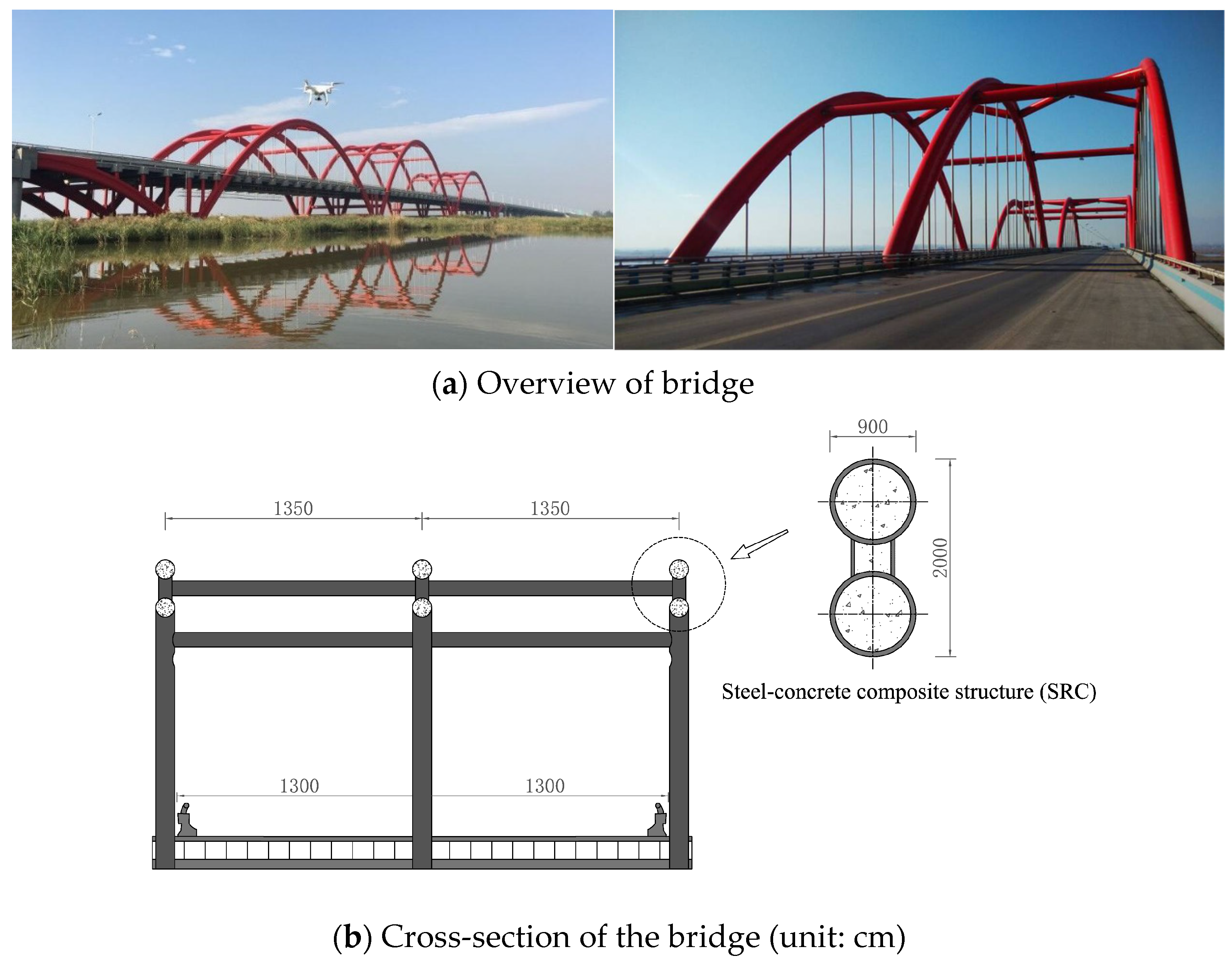

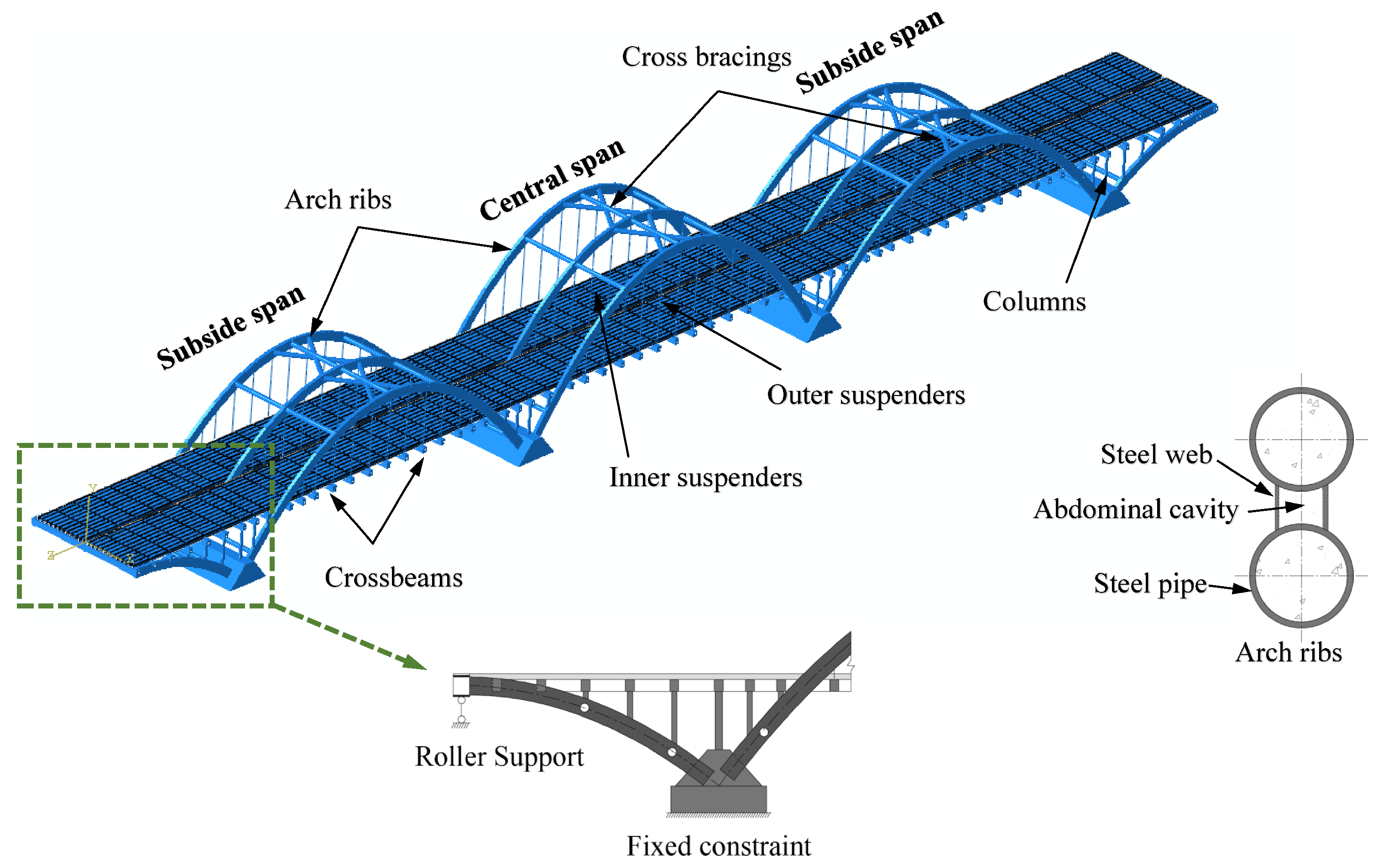

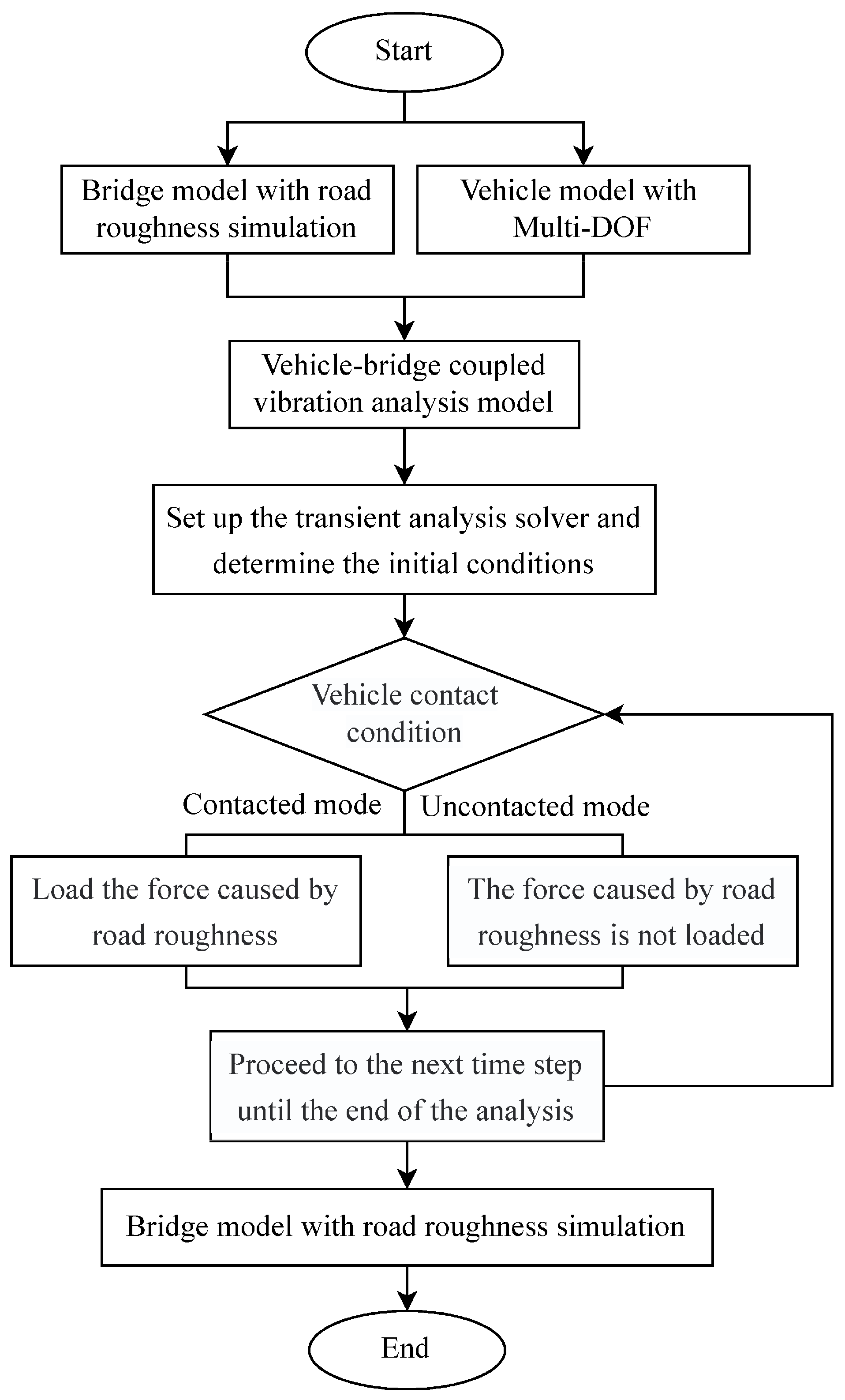

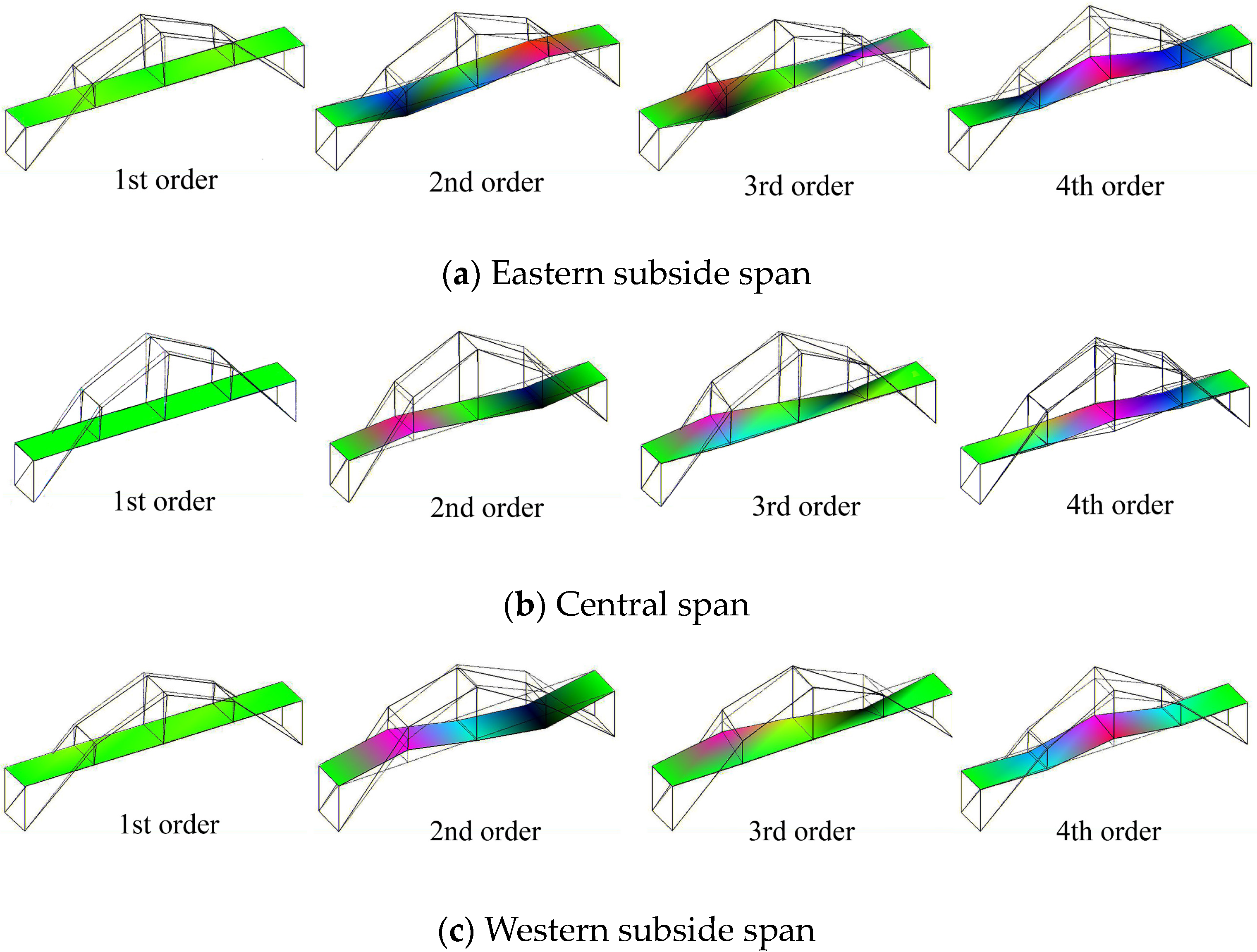
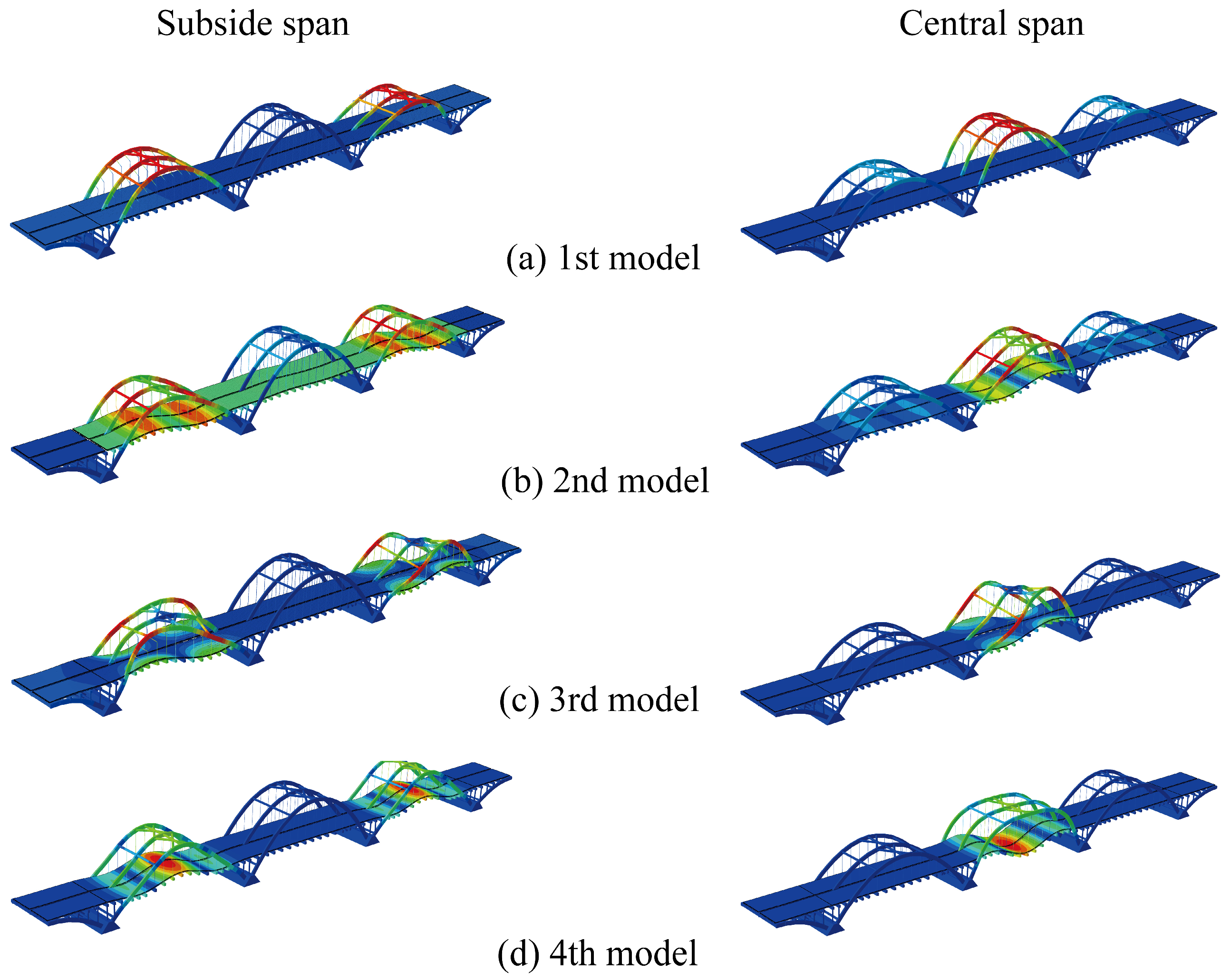

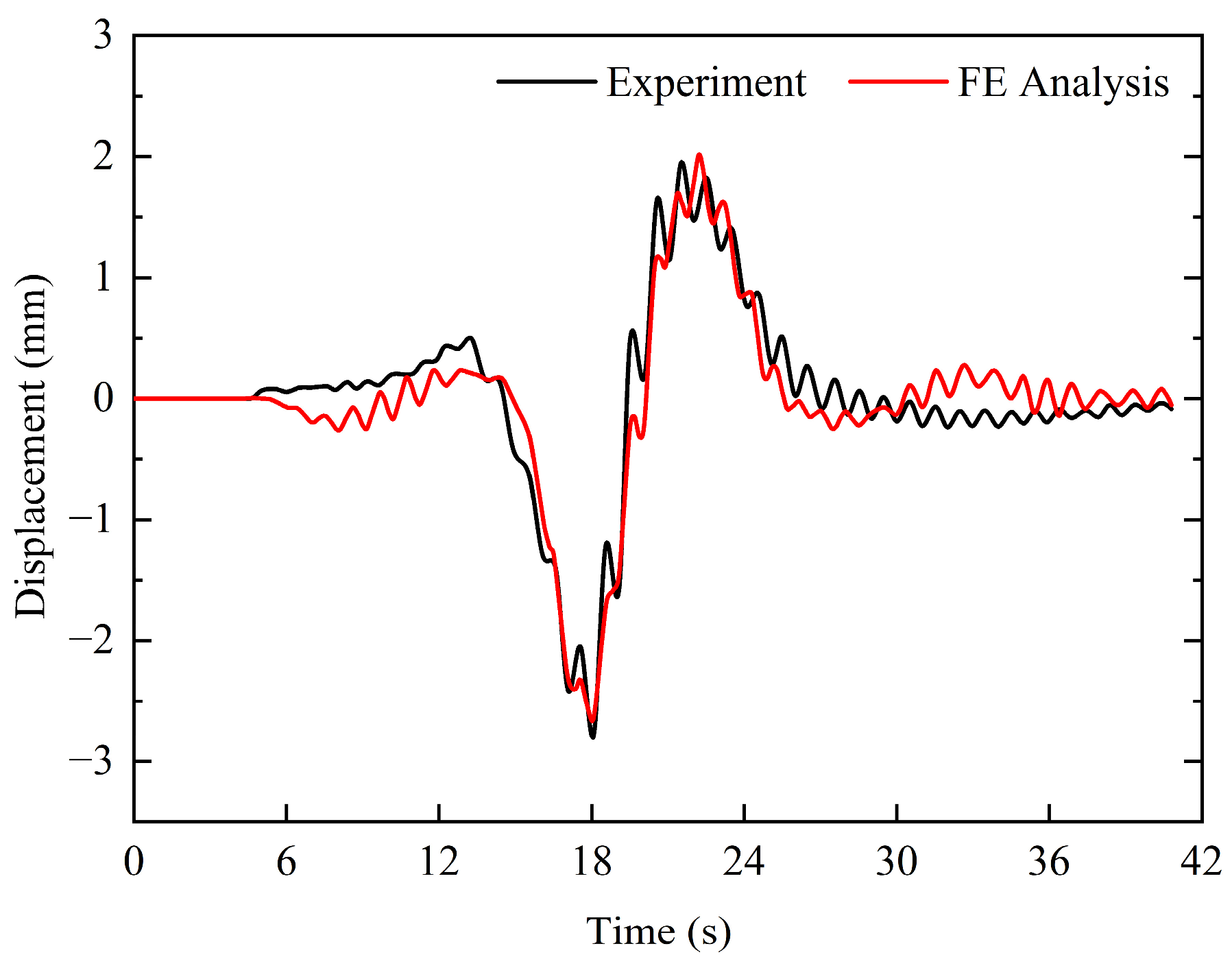
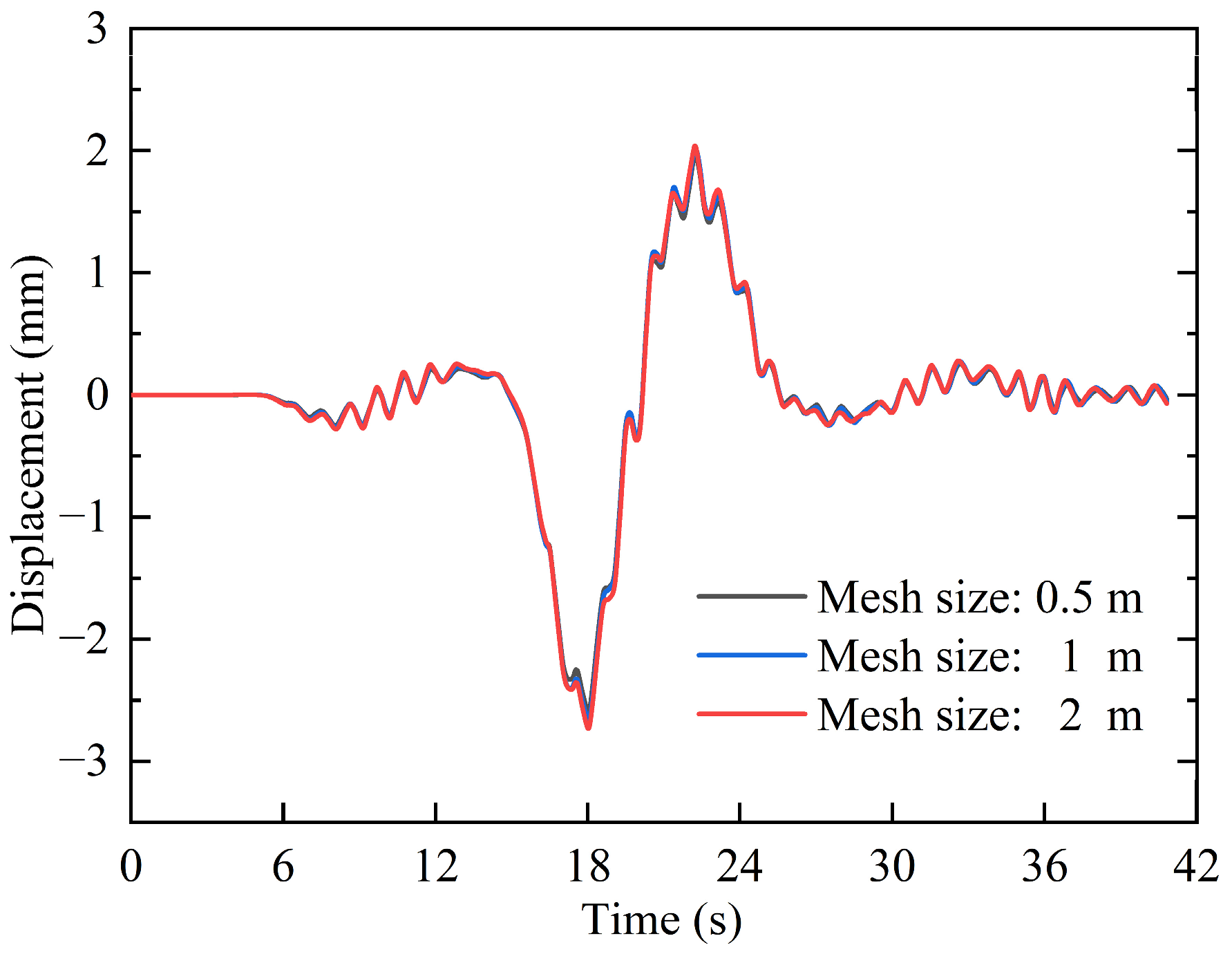
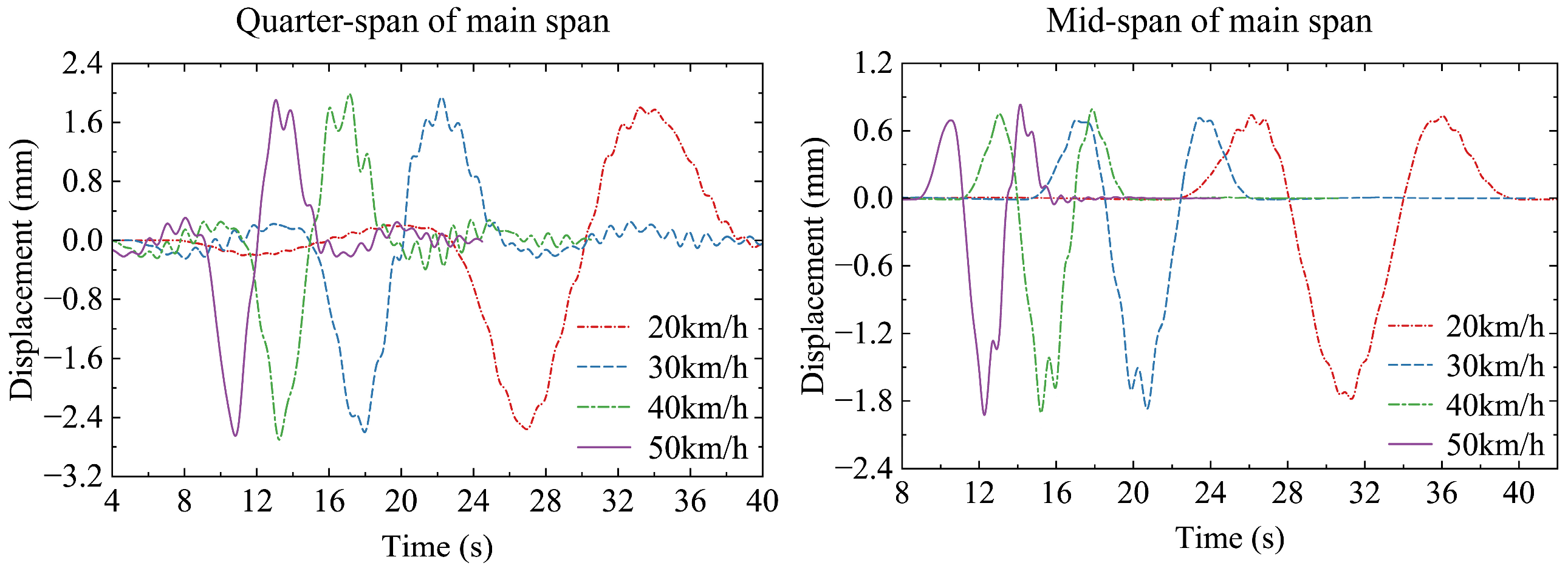
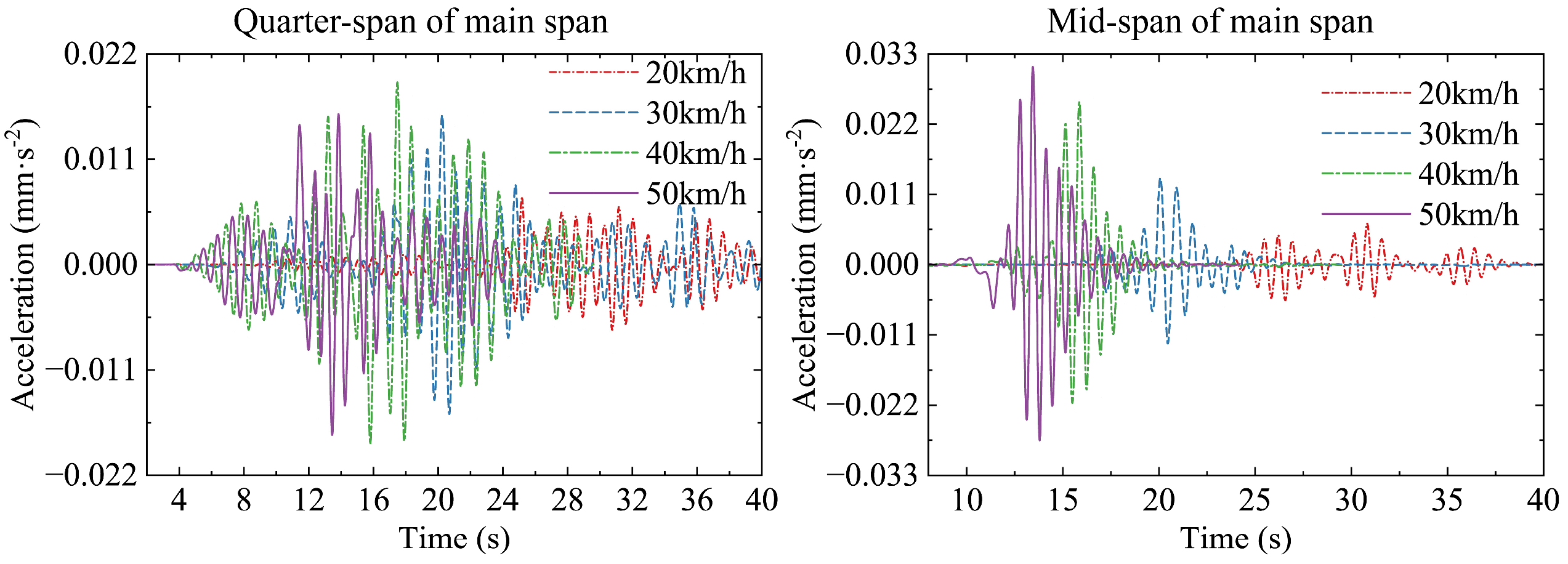
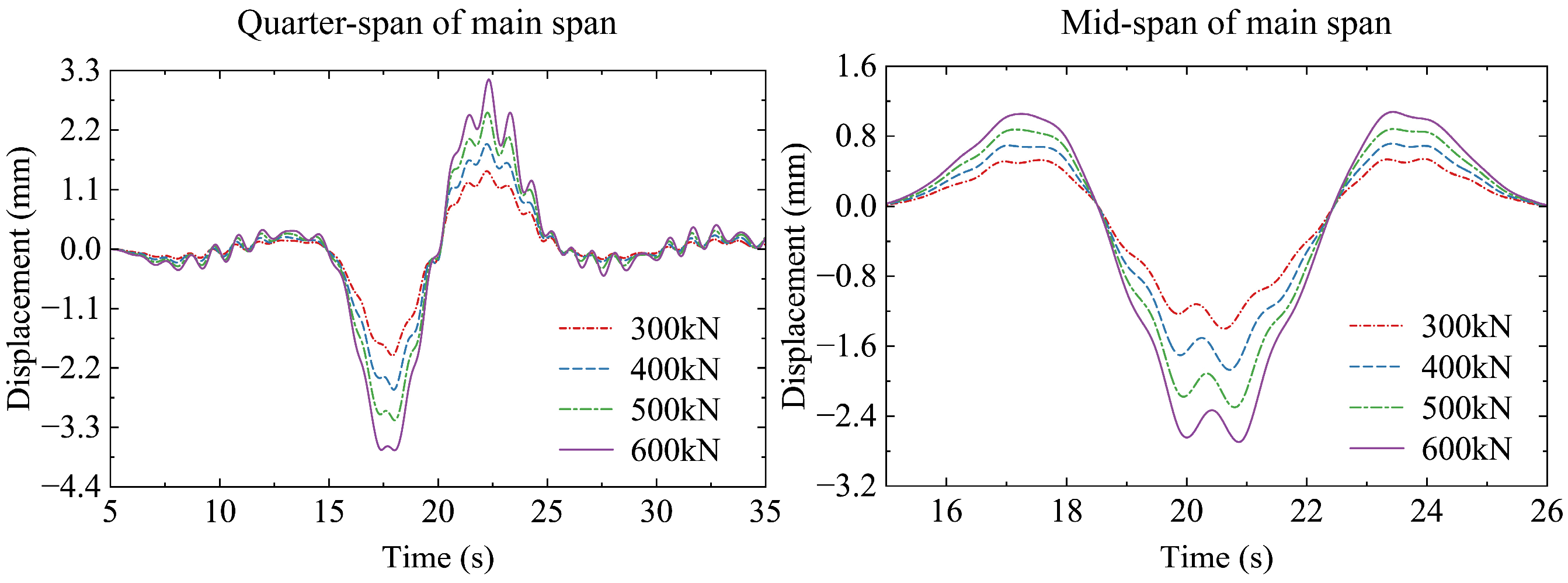
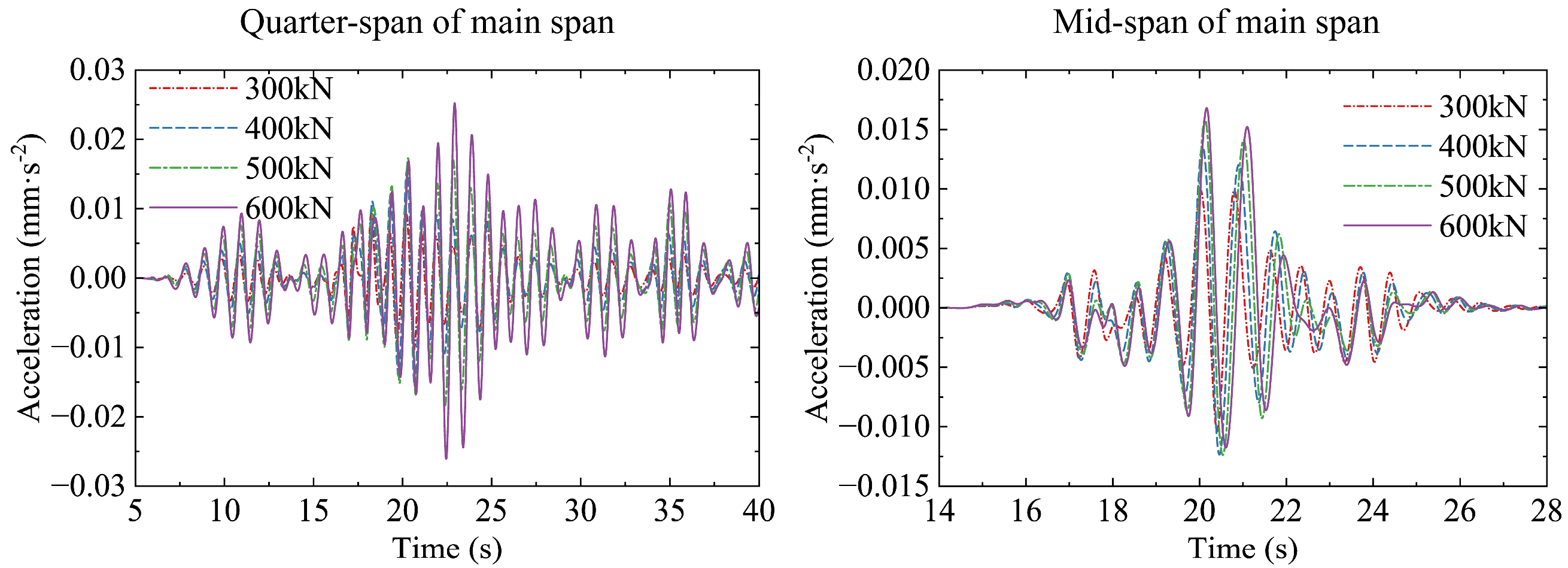
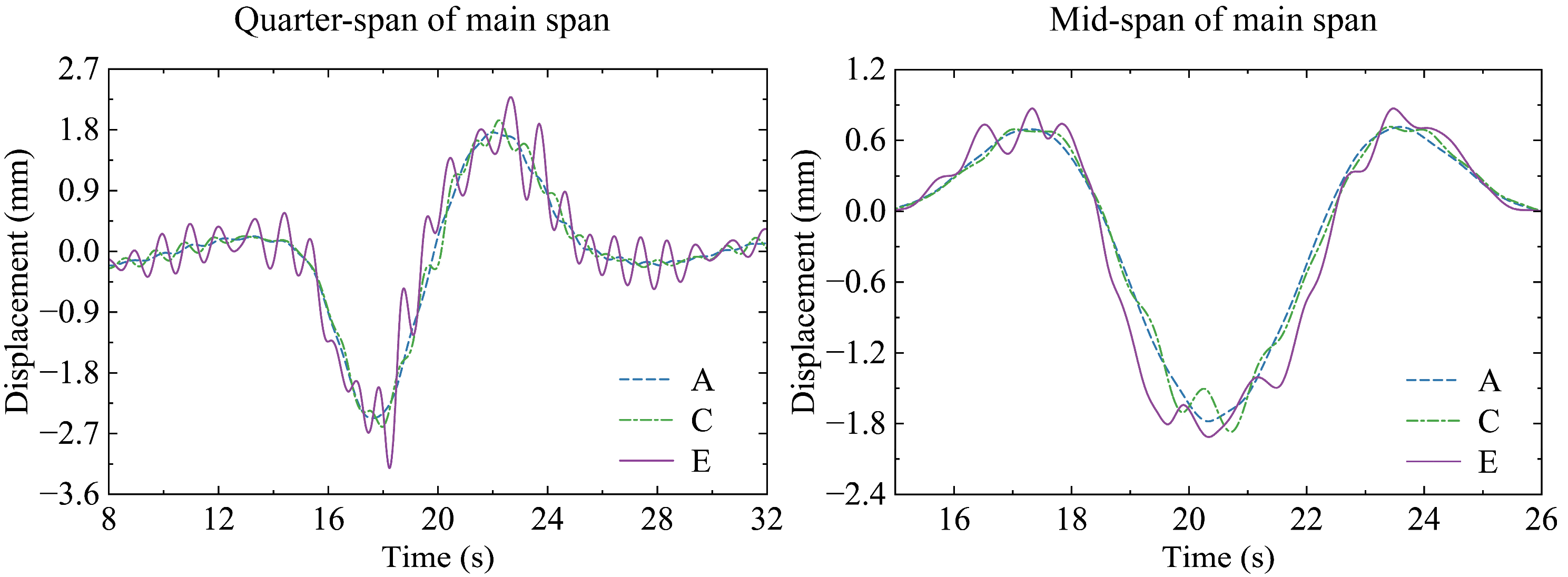


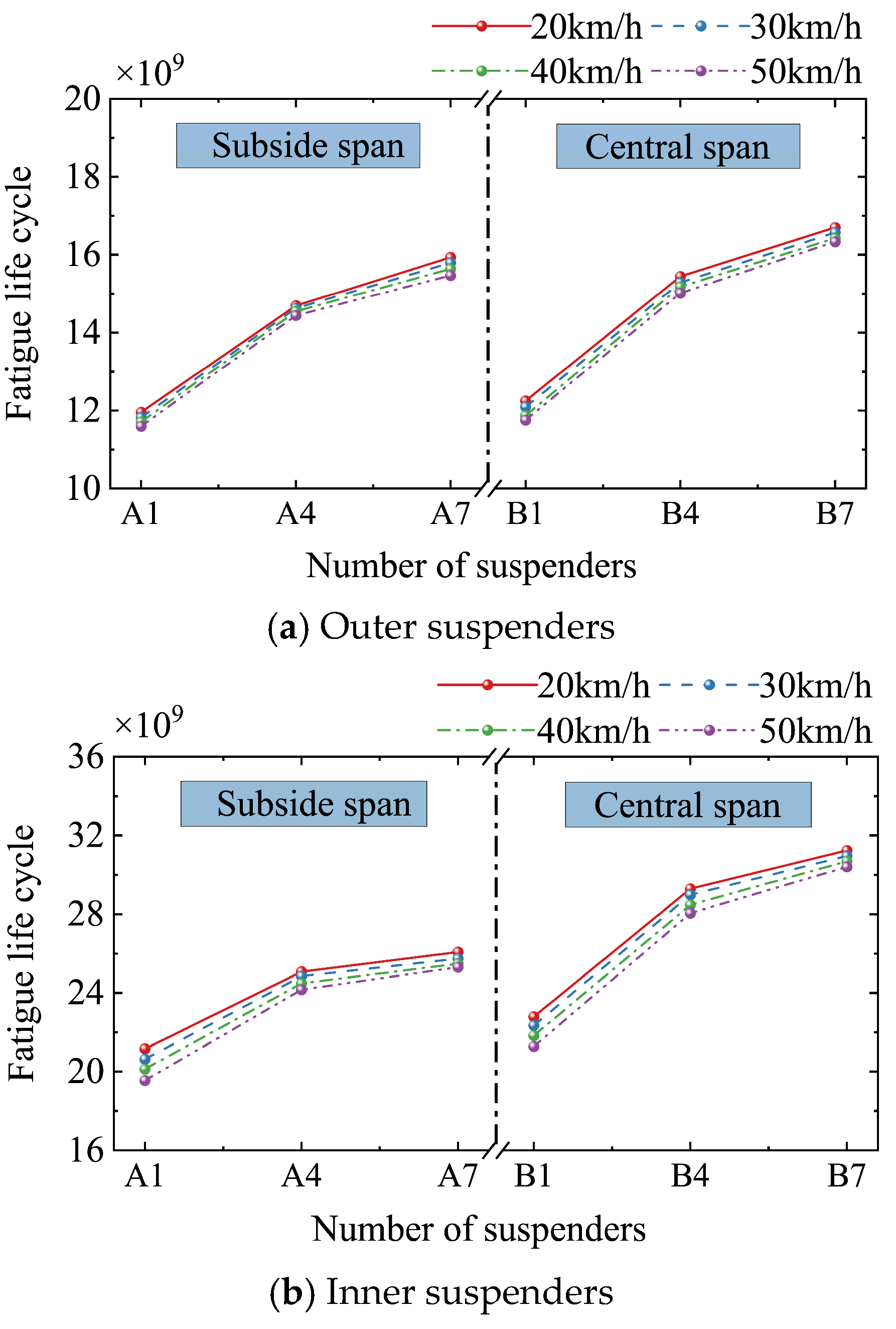



| Parameters | Values (kN·m−1) | Parameters | Values (kg) | Parameters | Values (kN·s·m−1) |
|---|---|---|---|---|---|
| Suspension stiffness Ks1, Ks2 | 300.0 | M1 | 2276.5 | Suspension damping Ds1, Ds2 | 10.0 |
| Suspension stiffness Ks3–Ks6 | 500.0 | M2 | 45,246.0 | Suspension damping Ds3–Ds10 | 53.0 |
| Suspension stiffness Ks7–Ks10 | 1250.0 | m1 | 700.0 | Suspension damping Dt1–Dt10 | 3.0 |
| Tire stiffness Kt1, Kt2 | 1500 | m3, m5 | 1000.0 | ||
| Tire stiffness Kt3–Kt10 | 3000.0 | m7, m9 | 800.0 |
| Materials | Elasticity Modulus (MPa) | Unit Weight (kN·m−3) | Poisson’s Ratio | Compression Strength (MPa) | Tensile Strength (MPa) | Coefficient of Linear Expansion |
|---|---|---|---|---|---|---|
| C50 | 34,500 | 25.0 | 0.167 | 32.4 | 2.65 | 0.000010 |
| C40 | 32,500 | 25.0 | 0.167 | 26.8 | 2.40 | 0.000010 |
| Materials | Elasticity Modulus (MPa) | Unit Weight (kN·m−3) | Poisson’s Ratio | Yield Strength (MPa) | Coefficient of Linear Expansion |
|---|---|---|---|---|---|
| Q345D | 205,000 | 7850 | 0.3 | 315 | 0.000012 |
| Prestressed strand | 195,000 | 7850 | 0.3 | 1860 | 0.000012 |
| Parallel wire | 205,000 | 7850 | 0.3 | 1670 | 0.000012 |
| Subsystem Type | Effect Factor | Parameter Range |
|---|---|---|
| Vehicle | Speed (km/h) | 20, 30, 40, 50 |
| Weight (kN) | 300, 400, 500, 600 | |
| Bridge | Road surface condition | A, C, E |
| Subsystem Type | Effect Factor | Parameter Range | Stress (MPa) | Deflection (mm) | Impact Coefficient |
|---|---|---|---|---|---|
| Vehicle | Vehicle speed (km/h) | 20 | 0.96 | −1.80 | 0.11 |
| 30 | 1.06 | −1.94 | 0.20 | ||
| 40 | 1.10 | −2.03 | 0.25 | ||
| 50 | 1.12 | −2.05 | 0.26 | ||
| Vehicle weight (kN) | 300 | 0.74 | −1.42 | 0.28 | |
| 400 | 1.06 | −1.94 | 0.20 | ||
| 500 | 1.37 | −2.33 | 0.14 | ||
| 600 | 1.65 | −2.63 | 0.08 | ||
| Bridge | Road surface condition | A | 0.98 | −1.82 | 0.12 |
| C | 1.06 | −1.94 | 0.20 | ||
| E | 1.07 | −1.96 | 0.21 |
| Vehicle Speed (km/h) | Non-Corrosion | Corrosion | Error Percentage (%) |
|---|---|---|---|
| 20 | 4.99 | 4.12 | 17.6 |
| 30 | 4.99 | 4.11 | 17.6 |
| 40 | 4.98 | 4.10 | 17.6 |
| 50 | 4.98 | 4.10 | 17.7 |
| Vehicle Weight (kN) | Non-Corrosion | Corrosion | Error Percentage (%) |
| 300 | 5.36 | 4.55 | 15.1 |
| 400 | 4.99 | 4.11 | 17.6 |
| 500 | 4.68 | 3.73 | 20.2 |
| 600 | 4.43 | 3.39 | 23.5 |
| Road Surface Condition | Non-Corrosion | Corrosion | Error Percentage (%) |
| A | 4.96 | 4.08 | 17.8 |
| C | 4.89 | 3.99 | 18.4 |
| E | 4.76 | 3.84 | 19.4 |
Disclaimer/Publisher’s Note: The statements, opinions and data contained in all publications are solely those of the individual author(s) and contributor(s) and not of MDPI and/or the editor(s). MDPI and/or the editor(s) disclaim responsibility for any injury to people or property resulting from any ideas, methods, instructions or products referred to in the content. |
© 2024 by the authors. Licensee MDPI, Basel, Switzerland. This article is an open access article distributed under the terms and conditions of the Creative Commons Attribution (CC BY) license (https://creativecommons.org/licenses/by/4.0/).
Share and Cite
Hu, W.; Zhou, B.; Zheng, X. Fatigue Evaluation of CFST Arch Bridge Based on Vehicle–Bridge Coupling Vibration Analysis. Buildings 2024, 14, 1787. https://doi.org/10.3390/buildings14061787
Hu W, Zhou B, Zheng X. Fatigue Evaluation of CFST Arch Bridge Based on Vehicle–Bridge Coupling Vibration Analysis. Buildings. 2024; 14(6):1787. https://doi.org/10.3390/buildings14061787
Chicago/Turabian StyleHu, Wenliang, Bin Zhou, and Xiaobo Zheng. 2024. "Fatigue Evaluation of CFST Arch Bridge Based on Vehicle–Bridge Coupling Vibration Analysis" Buildings 14, no. 6: 1787. https://doi.org/10.3390/buildings14061787






